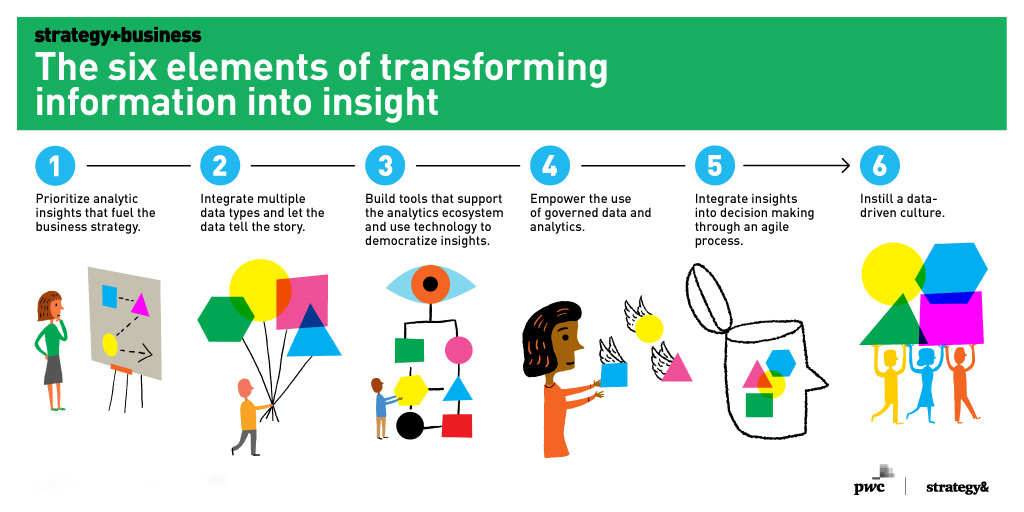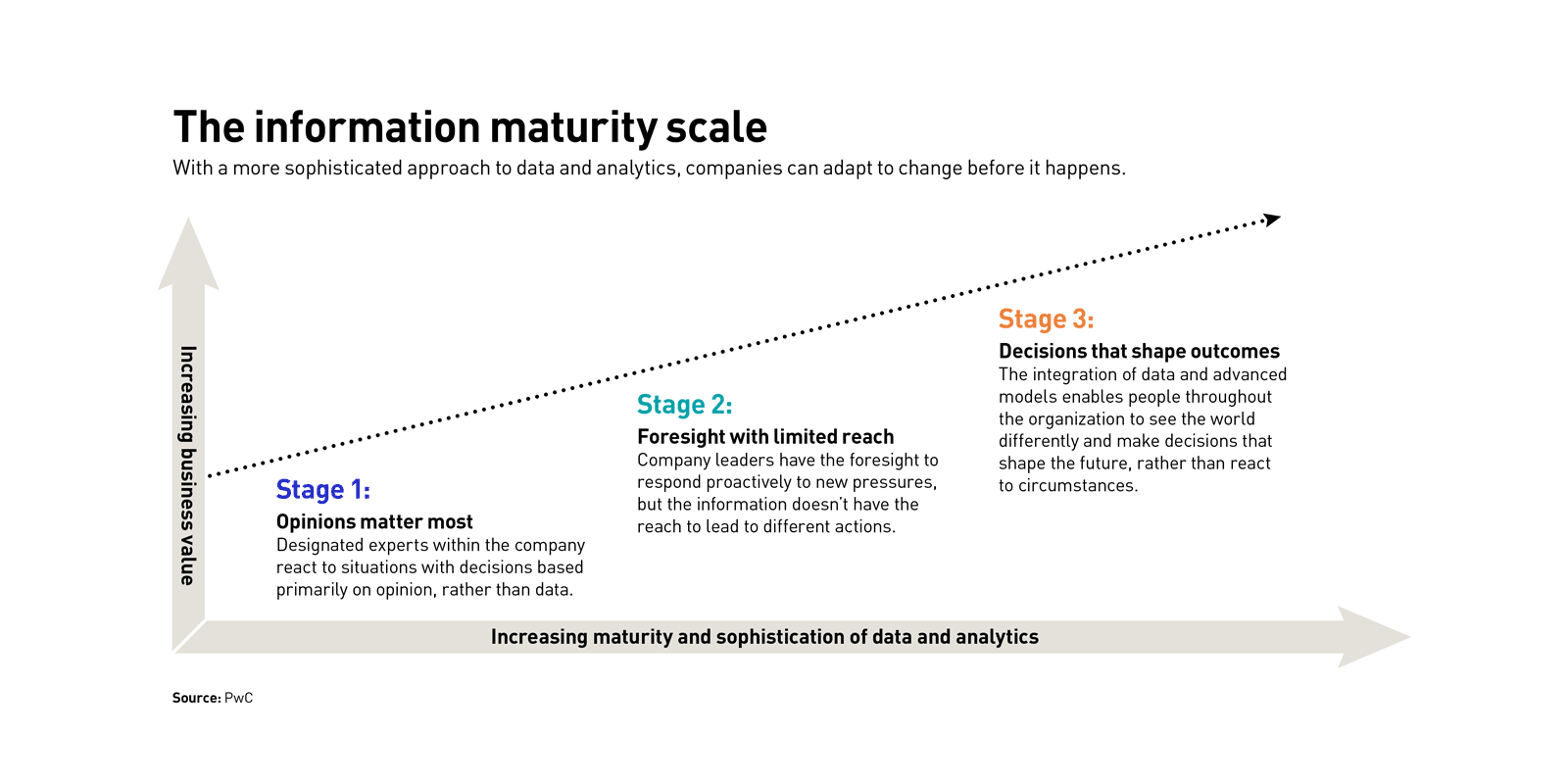How companies can transform information into insight
Focus on six organizational elements to build a world-class data and insights capability in the post–COVID-19 world.
A version of this article appeared in the Winter 2020 issue of strategy+business.
As the coronavirus pandemic unfolded, one leading global engineering and technology services company found itself well positioned to meet unprecedented challenges. The firm had kicked off a digital transformation project the year before, including investing in a data and analytics program equipped with advanced tools. For example, it enhanced digital collaboration among engineers using next-generation design software, it automated resource allocation based on skill sets, and it offered business reporting on executive mobile devices.
A few weeks into the crisis, it became clear that in several major countries in which the company operated, engineering and construction were likely to be considered essential services. The chief information officer began scenario planning. He determined that supporting remote work would be critical in the weeks and months that followed and asked regional leadership and IT teams to accelerate training programs for remote working and the recently launched digital tools. He also asked for a cybersecurity assessment to highlight vulnerabilities and risks, and had his procurement and telecommunications teams contract for additional bandwidth. As a result of these moves, employees were able to seamlessly deliver sophisticated infrastructure and architectural designs to their customers.
Other companies struggled to keep pace with the rate of change. It took the leaders of one global automotive components manufacturer nearly a month to obtain the information and insights needed to make critical staffing changes at various facilities; they later struggled to understand their suppliers’ readiness to restart production. Elsewhere, consumer goods companies lacked the ability to read signals about changing consumer preferences during lockdowns, such as increased demand for kitchen tools and home gym equipment. Some automakers had insufficient information about the financial health of their Tier Two and Tier Three suppliers, hindering efforts to accurately assess risk to assembly operations worth billions of dollars.
Although responses to the crisis and the success of those responses have been varied, a common theme has emerged: Business leaders need an effective way to capture, receive, interpret, and act on information, and to add predictive power and agility to their organization. By ensuring streamlined data availability and using advanced analytics in combining new sources of data to develop proprietary insights, leaders can reveal crises before they wreak havoc, uncover competitive pressures before they threaten market share, and surface opportunities before they become someone else’s advantage. Now is the time for companies to invest in and enhance these data and analytics capabilities as part of their broad digitization efforts.
Companies have recognized this urgency. For example, in a PwC study that surveyed more than 1,600 supply chain executives and decision makers in 33 countries between October and November 2019, 63 percent of Digital Champions — companies ahead of the curve in supply chain excellence — reported that they had already implemented an AI and advanced analytics platform, and another 24 percent said they were piloting such software. (It is worth noting, however, that Digital Champions made up just 9 percent of the overall sample.)
Our own discussions with senior executives at several major companies have revealed that even as they recover from the more immediate effects of the pandemic, leaders are rethinking their competitive strategies and how they will reconfigure their businesses to be more resilient in the future. As they adapt to a new reality and cope with the immense challenges of asymmetry, disruption, age (demographic pressures), polarization, and trust, they will need the ability to manage and draw insights from their information.
At the same time, the advancement and affordability of key technologies has dramatically enhanced the transformative power of information. Consider, for example, the proliferation of connected sensors and infinitely scalable computing and storage capabilities at price points that are compelling for a number of new use cases, coupled with the development of increasingly accessible machine learning (ML) and AI tools. The technology is there, and many companies are already using it. For instance, in manufacturing organizations, IoT solutions that include facial recognition are being used to eliminate “badge swapping,” which puts unapproved people in a tool crib or uncertified operators at the controls of a machine.
Sanjay Ravi, general manager of Microsoft’s automotive industry, observes, “Companies are now getting more real-time signals than ever before from their products, operations, and customers. This real-time information, combined with advanced AI technologies, helps companies gain critical insights to enable more efficient ways of doing business.”
But bringing this vision to life by building a high-caliber data and information capability can’t be accomplished overnight. In fact, if there is one thing that the coronavirus crisis made clear to many companies, it’s that their information value chain had gaps that could create serious problems during challenging times — gaps not easily overcome. What may not be as clear, then, is how companies should begin their journey to data and analytics excellence.
Organizations can think of their data and analytics journey as progressing along a maturity scale. At each stage, companies build their proficiency in six critical organizational elements:
1. Business decisions and analytics: Prioritize analytics insights that fuel the business strategy, not those that just report what’s happening.
2. Data and information: Let the data tell a story through the flexible integration of multiple data types, rather than forcing the data into a predefined model.
3. Technology and infrastructure: Build tools that support the analytics ecosystem, including AI, and democratize insights through analytics-as-a-service (AaaS).
4. Organization and governance: Establish an operating model to empower the use of governed data and analytics.
5. Process and integration: Ensure insights are rapidly integrated into decisions through an aligned, agile process.
6. Culture and talent: Instill a data-driven culture that blends business knowledge and analytics insights across all levels.
Certain elements will play a more visible role at different points along the maturity scale (see “The information maturity scale”), but ultimately, excellence in all six is required to realize the full value of a data and analytics transformation.
In the first stage, companies generally begin to accumulate significant quantities of data and information, but it is sporadic and requires labor-intensive manual processes to stage and validate. Data is siloed and analytics is limited to historic performance — the insights don’t help shape future performance. Moreover, the data doesn’t always tell a consistent story across the enterprise (or worse, it tells outright conflicting stories). Companies at this first stage are likely to have developed some of the technology and infrastructure needed to support the analytics ecosystem, but usage is typically limited.
The experiences of the first stage often lead executives to view the road to information maturity as too onerous to travel, and despite having some pockets of data-focused activity, they still rely more on expert opinion to make decisions. The data and analytics system as a whole is not yet delivering business insights.
When companies are able to move to stage two, it is because they are beginning to ensure that the insights produced are aligned with their business strategy — there is a clear connection between business decisions and analytics. To support this transition, the need for organization and governance becomes clear. Companies start defining processes that will deliver cleaner data more effectively. By the end of this stage, companies typically have a center of excellence that delivers enterprise-wide insights to all business stakeholders across a harmonized data infrastructure. Company leaders have gained the foresight to see disruptions or competitive pressures coming, and to make data-driven decisions to prepare for them — but this is happening only at the highest level.
At this point, company leaders ask themselves: Why can’t we make better decisions given everything we’ve done so far? To move the needle, organizations must focus on process and integration and culture and talent. Doing so leads them to the third stage, in which data and insights are shared transparently across the company, and any questions concerning data ownership are resolved. Leaders view the business as a “knowledge company,” with analytics and insights firmly embedded in decision-making processes. They create a culture that is ready to take advantage of the insights, cultivating talent to support data optimization: Companies need a digitally upskilled workforce prepared to adopt the new tools and technologies.
In addition, when companies have reached peak maturity, many types of data are brought together. This is true for information generated within different business units — the analysis is cross-functional. But it is also true with regard to data from outside sources, such as market data, supplier health data, and customer behavior data. Moreover, companies at the third stage use a rich variety of algorithms and AI/ML tools to put all this data to work, and extract insights beyond the capacity of the human brain to tell stories that would otherwise remain hidden.
In other words, through the three stages, companies move from the “what” (accumulating information that illustrates what happened), to the “so what” (contextualizing insight that explains why it happened), to the “what next” (asking what they should do to rewrite the script, either to capture opportunities that are not yet obvious or to prepare for challenges that have not yet hit). They don’t just see the factors that could impact their performance — they see how to change those factors in ways that shape their market. One of the authors, for example, is currently working with a global conglomerate in the industrial and technology sector to build a dynamic data model that pulls in data from the company’s facility location database, employees’ home addresses, and third-party data on city and regional COVID-19 incidence to provide a daily risk report and mitigation strategy to company leaders.
When companies reach peak information maturity, they don’t just see the factors that could impact their performance — they see how to change those factors in ways that shape their market.
Another example of a mature data and analytics program, says Microsoft’s Ravi, comes from the automotive sector: “This sector generates vast amounts of data. However, many companies aren’t yet set up to turn it into relevant insights.” To bridge this gap, one leading automotive company developed “an underlying data platform that brings in signals from different parts of the business, and now they are building the artificial intelligence layer on top of it to help their employees make effective decisions. Through what we call a digital feedback loop, the entire enterprise is connected with relevant data — whether pertaining to relationship management with customers and partners, engagement with employees, core product creation, or enterprise operations — to drive continuous improvement in products and services.” Moreover, Ravi explains, “in the past, a lot of this data would be geographically confined. With this new model, the company can bring initiatives from one part of the world to a number of [other] countries in a fraction of the time that it would have taken in the past.”
The coronavirus pandemic should be a wake-up call for companies that have yet to start their information value chain evolution or that have been idling at an early stage. Anecdotally, we have heard from several companies that COVID-19 has been a catalyst for rapid digital transformation and the adoption of new technologies. Whether leaders thought they could wait, or thought they could get by with less sophisticated capabilities, or were unsure how and where to start, they now see that transforming information into insight will be key to reinvention — both during recovery and in the post-crisis world.
Author profiles:
- Anil Khurana is PwC’s global industrial manufacturing and automotive leader. He has expertise working with industrial and manufacturing companies on strategy, operations, new business models, capability development, and tech-enabled transformation. Based in Boston, he is a principal with PwC US.
- Roger Wery is PwC’s global advisory technology, media, and telecommunications industry leader, with expertise advising software, electronics, and communications companies on growth and innovation strategy; M&A strategy; and business, digital, and operating model transformation. Based in San Francisco, he is a principal with PwC US.
- Amy Peirce works with companies to apply data and analytics capabilities to structure, solve, and manage critical issues facing their organizations, and developed PwC’s customer insights platform to help executives define customer initiatives that drive new growth, facilitate better customer engagement, and support digital and customer-centric business transformation. Based in San Jose, Calif., she is a principal with PwC US.





